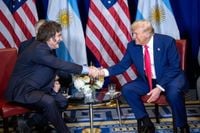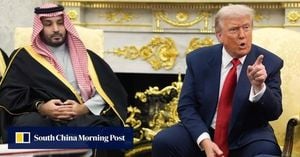On August 11, 2025, President Donald Trump declared a “crime emergency” in Washington, D.C., assuming temporary control over the city’s police force in a move that has reignited fierce debate over crime, governance, and the direction of U.S. policy at home and abroad. Trump’s decision, announced in a dramatic press conference, was justified by his depiction of the nation’s capital as “dirty” and “dangerous,” and he compared Washington unfavorably to major Latin American cities like Bogotá and Mexico City. “It’s a natural instinct as a real estate person,” Trump remarked, likening his ambitions for the city to the gold-trimmed renovations he once ordered at the White House.
Yet, as The New York Times and the BBC have both reported, the president’s dire rhetoric stands in stark contrast to official crime statistics. According to the Metropolitan Police Department (MPDC), violent crime in Washington, D.C., has actually dropped to its lowest level in three decades. In 2024, violent crimes fell by 35%, and so far in 2025, the city has seen a further 26% decrease compared to the same period last year. Robberies are down 28%. FBI data corroborates this trend, with homicides in 2023 at 40 per 100,000 residents—the highest in 20 years, but still below the rates seen in the 1990s and early 2000s. In 2024, the homicide rate declined, and by August 2025, it had dropped another 12%.
Despite these numbers, Trump and the D.C. police union have questioned the accuracy of the data, with the union—representing over 3,000 officers—supporting the federal intervention as a temporary measure to address what they describe as a “surge” in violent crime, historic officer shortages, and eroded morale. The union’s cautious endorsement stands in contrast to the criticism from civil rights groups and local leaders, who warn about the dangers of setting a precedent for federal control over local governance.
In his speech, Trump invoked the “broken windows” theory, a controversial policing strategy from New York’s past, arguing that tackling minor infractions would prevent more serious crimes. He cited a lesson from his father, Fred Trump: “If the front door of a restaurant is dirty, the kitchen’s dirty also. Same thing with the capital: if our capital’s dirty, our whole country is dirty.”
But the numbers tell a nuanced story. As of August 11, D.C. had recorded 99 homicides, including the tragic killing of a 21-year-old congressional intern caught in crossfire. Carjackings, another focal point of Trump’s claims, have actually decreased: there were 189 reported through August 2025, compared to 300 the previous year. The Council on Criminal Justice (CCJ) noted that carjackings peaked at 140 incidents in June 2023, but have since declined. Since July 2025, a citywide night curfew for minors under 17 has been implemented to target youth crime.
When comparing D.C. to other major U.S. cities, the capital’s level of violence remains higher than average, but the downward trend is consistent with national patterns. Between January and June 2025, the homicide rate in D.C. fell 19%, compared to a 17% drop across 30 large U.S. cities. However, compared to the same period in 2019, D.C.’s homicide rate has only decreased by 3%, while the national average fell by 14%.
Trump’s approach to crime and urban renewal is not new. As The New York Times reminds readers, he has a history of tough-on-crime rhetoric dating back to his days as a New York businessman, including his infamous 1989 ads calling for the death penalty in the Central Park Five case—those accused were later exonerated, and Trump never apologized. His family’s real estate business faced lawsuits for discrimination against Black tenants in the 1970s, and as president, he deployed federal forces in response to protests in the capital during his first term.
Critics view the current police intervention as an overreach that threatens civil liberties and local autonomy. Skye Perryman of Democracy Forward warned that Trump’s actions “threaten civil liberties,” while Maya Wiley of The Leadership Conference on Civil and Human Rights argued that his language about “dirty” and “crime-ridden” cities is often coded in terms that target racially diverse communities.
Trump’s domestic policies reflect a broader shift in U.S. governance under his second administration, where the “America First” agenda has gained renewed vigor. On August 13, 2025, the Toss Securities Research Center released a report titled “I’m Back, Washington, D.C.—01. MAGA is a slogan that will not disappear.” The report, based on a visit to Washington by the center’s head, Lee Young-gon, argued that the “America First” stance is not unique to Trump but is rooted in longstanding traditions of U.S. isolationism and economic protectionism. From George Washington’s farewell speech to the Monroe Doctrine of 1823, through the Smoot-Hawley Tariff Act and Ronald Reagan’s 1980s campaigns, the theme of prioritizing American interests has repeatedly surfaced, especially in times of crisis.
This same approach is evident in Trump’s foreign policy, particularly in Latin America. On February 22, 2025, Trump met with Argentine President Javier Milei at CPAC, praising Milei’s right-wing reforms and calling him his “favorite president.” Trump has called on the International Monetary Fund to raise $2 billion to support Argentina’s economic overhaul. Meanwhile, he has wielded tariffs as a blunt instrument of policy, imposing a 50% tariff on Brazilian goods on August 6, 2025. While officially justified by concerns over Brazil’s Pix instant payment system, the move is widely seen as punishment for the leftist government of President Luiz Inacio Lula da Silva and its efforts to “de-dollarize” the economy in partnership with other BRICS nations.
Trump’s administration has also tightened sanctions on Cuba and Venezuela, returning Cuba to the list of state sponsors of terrorism and slapping a 25% tariff on buyers of Venezuelan oil. These measures, alongside support for right-wing allies like former Brazilian president Jair Bolsonaro, highlight a transactional, ideologically charged approach to the region. The administration has pressured Latin American countries to distance themselves from China, with Secretary of State Marco Rubio visiting five nations early in his term to discourage further expansion of China’s Belt and Road Initiative. Efforts to prevent Chinese control over critical ports and strategic resources have intensified, as the U.S. seeks to counter Beijing’s growing influence in what it still considers its “backyard.”
For Latin American governments, this new U.S. posture presents a complex set of choices: align with Washington, cultivate closer ties with China, or attempt to balance between the two powers. Trump’s “backyard policy,” as analysts describe it, is the latest iteration of the centuries-old Monroe Doctrine, now infused with the president’s characteristic transactional style and “America First” priorities.
As debates swirl over crime, autonomy, and international relations, Trump’s second term is shaping up to be a test of how much the old traditions of U.S. policy can be adapted—or weaponized—for the challenges of a new era.




